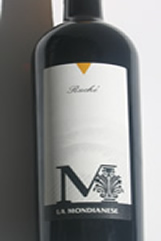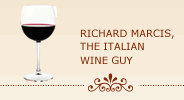Unexpected Pleasures — Fine Italian Wines From Off the Beaten Path
Italy produces a large, almost dizzying array of wines. With grapes growing in virtually every nook and cranny of this boot-shaped country, Italy produces more wine than any other country in the world. Moreover, with its geographically diverse terrain — seacoasts, rolling hills and mountains — and assorted climates — from the cool Alpine north to the warm Mediterranean south — Italy lays claim to hundreds of grape varieties, many of which have been grown successfully only in Italy.
And while some of Italy’s native varietals — such as Sangiovese and Trebbiano — are grown throughout Italy, other varietals only do well in particular regions or, in some cases, in specific subzones of regions. In addition to its native varietals, many internationally-famous varietals — such as Cabernet Sauvignon, Merlot and Chardonnay — are also grown in Italian vineyards. The net result is that there is no other country that has as diverse a wine arena as Italy.
Italy’s diverse array of wines can be bewildering and a recipe for confusion on the part of consumers trying to better understand and appreciate Italian wines let alone simply purchase a bottle of vino for that special-occasion dinner. Many wine consumers, intimidated by the variety of choices available, simply opt-out of the tough choices and stay with old reliables like Chianti and Pinot Grigio.
But the bounty of choices has certain advantages for the intrepid wine consumer, one of which is that because they are less popular, the off-the-beaten-track wines will typically sell at lower prices than their more popular competitors of comparable quality. This doesn’t mean they are necessarily cheap, just that their quality-to-price ratios may be higher. Perhaps more importantly, there is also the thrill of “discovering” that nuanced, finely-crafted wine that will give you bragging rights when served to guests at your dinner table or your wine tasting group.
Two such examples of Italy’s lesser known quality wines include the following:
Ruche di Castagnole Monferrato
If you’ve never heard of Ruche (pronounced roo kay), you’re in good company. The Ruche is a relatively scarce red grape varietal grown almost exclusively in the hills northwest of Asti around the commune of Castagnole Monferrato in the Piedmont region in northern Italy.
 Production is extremely limited and it is only in the last decade that Ruche has been marketed outside its production area. Spurred by the wine’s DOC (Denominazione di Origine Controllata) status (Ruche di Castagnole Monferrato was granted DOC status in 1987) and the initiatives of a few innovative producers, sales of Ruche wine, albeit still modest, have been growing steadily.
Production is extremely limited and it is only in the last decade that Ruche has been marketed outside its production area. Spurred by the wine’s DOC (Denominazione di Origine Controllata) status (Ruche di Castagnole Monferrato was granted DOC status in 1987) and the initiatives of a few innovative producers, sales of Ruche wine, albeit still modest, have been growing steadily.
In order to be labeled Ruche, the wine must be comprised of at least 90 percent Ruche with the remaining 10 percent Barbera or Brachetto. The wine has a bright ruby color with delicate floral and red berry aromas. It has medium body with a delicate, velvety taste with hints of black plums and some pepper.
It is a fruity, approachable and, yes, friendly wine that lacks the pretense of a big Barbera and that reminds me in some ways of a Dolcetto. It has good acidity but little tannin so it is a wine meant to be drunk young. While it compliments salami. roasted veal and aged cheeses, the best match may be with the classic Piedmont dish, tagliolini with white truffles.
Two of the best producers of Ruche whose wines are generally available in local markets in the U.S. include Crivelli and La Mondianese:
Crivelli, Ruche di Castagnole Monferrato 2006 ($18)
Clean and fresh with layers of flavors.
La Mondianese, Ruche di Castagnole Monferrato 2006 ($25)
Medium bodied with red berry fruit. Delicious.
Loredan Gasparini, Venegazzu Della Casa IGT Colli Trevigiani
The second fine Italian wine from off the beaten track is from the Veneto region in northeastern Italy. However, in this case it is not a grape varietal that is of interest but a Bordeaux-style wine that is unique for the Veneto region. Even though it’s been produced since the 1950’s, it’s not particularly well known in the United States.
First, some background. Conte Loredan Gasparini/Venegazzu (pronounced veh neh GAHD zoo) estate is located about 12 miles northeast of Treviso and a few miles east of Montebelluna, an area that has been noted for wines for centuries. Count Piero Loredan, a direct descendant of a Doge of Venice, founded the wine estate in 1950 in a beautiful Palladian villa.
Despite being located in a prestigious wine growing area known for its white wines and Rosso del Montello, Count Loredan decided not to follow the DOC rules and instead focused on growing traditional Bordeaux varietals — Cabernet Sauvignon, Cabernet Franc, Merlot and Malbec. Count Loredan was soon producing a series of magnificent Bordeaux-style red wines including the Venegazzu Della Casa and his stylish flagship wine Venegazzu Capo di Stato. In 1973, the estate was bought by the current owner, Giancarlo Pallo who shared the Count’s zeal for quality winemaking and continued producing classic Bordeaux-style wines.
The 2004 Venegazzu della Casa is a blend of 60 percent Cabernet Sauvignon, 25 percent Cabernet Franc, 10 percent Merlot and 5 percent Malbec. The wine spent 14 months in French oak barriques and 12 months in the bottle prior to release. The wine has a deep ruby hue and classic Cabernet aromas of black currant and plum. It is full-bodied with black fruit and subtle oak flavors, good tannins and a long finish. A fine, well-made wine that pairs well with grilled and roasted meats, game, fragrant pasta dishes, risottos and aged cheeses.
Sauvignon, 25 percent Cabernet Franc, 10 percent Merlot and 5 percent Malbec. The wine spent 14 months in French oak barriques and 12 months in the bottle prior to release. The wine has a deep ruby hue and classic Cabernet aromas of black currant and plum. It is full-bodied with black fruit and subtle oak flavors, good tannins and a long finish. A fine, well-made wine that pairs well with grilled and roasted meats, game, fragrant pasta dishes, risottos and aged cheeses.
The Venegazzu Capo di Stato is Venegazzu della Casa’s big brother, made from essentially the same grape mix but using grapes from lower-yielding, older vines and more time spent ageing in barriques. Former French President Charles de Gaulle, after whom the wine is named (Capo di Stato translates as president or literally, chief of state), was a big fan of Venegazzu Capo di Stato after having been served this wine at an official state dinner in Venice. If true, this is an amazing compliment given de Gaulle’s aversion to anything not French.
Loredan Gasparini, Venegazzu Della Casa IGT Colli Trevigiani 2004 ($25)
Velvety, dark fruit, seductive.
Loredan Gasparini, Venegazzu Capo di Stato IGT Colli Trevigiani 2003 ($28)
Stylish, violet and black currant flavors, awe-inspiring.
Note – prices indicated are generally the lowest available and will vary from store to store. While in stock at time of writing, stores may sell out of the selections so availability is not guaranteed. Call to check on price and availability before making the trip.
© Richard MarcisWine Words Wisdom
Return to wine review and musings ??



